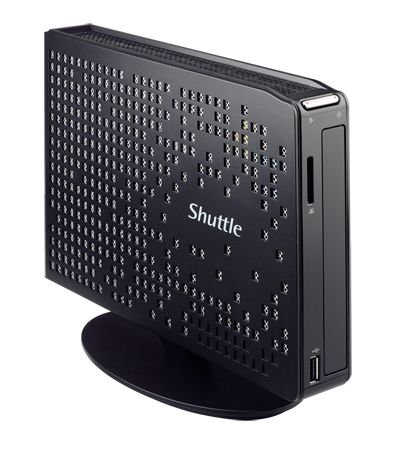A little while ago, Bay Trail-D (Desktop) motherboards started to show up for about $60 to $70, and I estimated a complete system with RAM, enclosure, and 1TB storage would cost around $250. Thanks to Shuttle XS35V4 and XS36V4, you can now buy such quad core system pre-assembled for well under $300, or just around $200 for a barebone system without RAM or storage.

Shuttle XS35V4 / XS36V4 specifications:
- SoC – Intel Celeron J1900 Quad core processor (Bay Trail-D) @ with Intel 7th generation graphics.
- System Memory – 1x DDR3L SO-DIMM, up to 8GB DDR3 1333 MHz
- Storage – 1x 2.5″ SATA HDD / SSD bay, 1x SD card reader. XS35V4 only: optical drive.
- Connectivity – 10/100/1000M Ethernet (Realtek RTL8411), 802.11b/g/n WLAN support (1T1R),
- Audio – Realtek ALC269, 2.1 channel High Definition Audio
- Front panel
- Power button
- Power & HDD LEDs
- SD Card reader
- 1x USB 2.0 port
- XS36V4 only – 1x RS232/RS422/RS485 with 0/5/12V, 1x RS232 with 0/5/12V
- XS35V4 only – ODD bay
- Back Panel
- RJ45 LAN port
- 1x D-sub port (VGA), 1x HDMI port, 1x Display port
- 1x USB 3.0 port, 3x USB 2.0 ports
- Line out port, MIC in port
- Kensington lock
- DC in
- Expansion slot – 1x Mini-PCIE slot (used for WLAN)
- Power Supply – 40W Power adapter (19V/2.1A); input 100-240V AC
- Dimensions
- XS36V4 – 200(L) x 36(W) x 160(H) mm
- XS35V4 – 252(L) x 38.5(W) x 162(H) mm
The computers are said to be compatible with “Windows 8/8.1 64bit OS”, but it’s very likely it would run Linux distributions just fine too. An optional VESA mount is also available, and for XS35V4 only you could also get an optional extra HDD bracket. Both PCs are pretty similar, but XS35V4 is slightly larger, and features an optical drive, whereas XS36V4 adds two serial ports which are missing in XS35V4. I was expecting a somewhat smaller power adapter, but I guess this is to provide enough power for internal and external peripherals connected to SATA or USB.
You can get more details on Shutlle XS35V4 and Shuttle XS36V4 product pages.
Via Liliputing.

Jean-Luc started CNX Software in 2010 as a part-time endeavor, before quitting his job as a software engineering manager, and starting to write daily news, and reviews full time later in 2011.
Support CNX Software! Donate via cryptocurrencies, become a Patron on Patreon, or purchase goods on Amazon or Aliexpress. We also use affiliate links in articles to earn commissions if you make a purchase after clicking on those links.




The link for Shuttle XS36V4 product page is incorrect, “http://” should go first not last. Though, it’s not a problem for a majority of the site audience )
There’s a BIOS update to give Windows 7 compatibility on Shuttle’s website, details here: http://global.shuttle.com/unique/productsFaqDetail?faqId=2265
It gives you an OS selection option in the BIOS where you can select either Windows 7 or 8.x. I don’t know what this actually does though and I would really like to know.
@Yar Rick
Thanks for the report. I fixed the link.
@anonymous
Maybe Windows 7 requires BIOS boot, and Windows 8.x UEFI boot?
You probably get better value with the DS437 for about the same price: http://www.shuttle.eu/products/slim/ds437/specification/
The DS437 model might have less raw computing power, but it is advertised to come with drivers for Linux and Windows down to XP. Most significantly, its processor supports VT-x with Extended Page Tables, which the Bay-Trail-based Celerons don’t support. It also allows 16 GB of RAM where the XS3xV4 allows only 8 GB. The DS437 also has more Ethernet ports. Idle power consumption is 5 W higher though.
What are the advantages of VT-x with Extended Page Tables? :s
@onebir Some operating systems like SmartOS require it for KVM, see http://wiki.smartos.org/display/DOC/Hardware+Requirements. Generally, it helps virtualization, see also http://en.wikipedia.org/wiki/Second_Level_Address_Translation.
The DS437 also has an additional mSATA connector, so that you can have more storage (mSATA SSD + normal 2.5″ hard disk drive). The HD Graphics on the Celeron 1037U should also have more execution units (6 instead of 4) than the Celeron J1900.
Sure, whether it is better for you or not depends on your needs. For example, in the Celeron 1037U, Quick Sync Video is deactivated, not so in the J1900, see http://en.wikipedia.org/wiki/Intel_Quick_Sync_Video. So certain workloads might be faster on one processor and slower on the other and vice versa with other workloads.
You always need to look at the details. For instance, none of these two processors supports VT-d, so you virtually cannot allow user-space software access to devices with direct memory access, if you don’t want to be exposed to the risk that the user-space software corrupts your kernel space. You would need an IOMMU to prevent user-space software from misprogramming a DMA device.
@onebir
VT-x represents Intel’s technology for virtualization on the x86 platform (ability to play vmx images of other OS) – http://en.wikipedia.org/wiki/X86_virtualization#Intel_virtualization_.28VT-x.29
Extended Page Tables is a feature called “unrestricted guest” on Intel’s x86 virtualization technology – http://en.wikipedia.org/wiki/Extended_Page_Table#Extended_Page_Tables
In poor words is the Intel’s virtualization technology improved
@Jibril
@tzij
Thanks guys 🙂
They have a V5 now with N3050 SoC: http://global.shuttle.com/unique/productsDetail?productId=1930
@Roel
uhmmm…better if equipped with a Braswell quad core… (Intel Pentium N3710)
@Jibril
Yes, but I think they use the N3050 for 2 reasons: thermal design and the competition with the v4 who has a J1900 (and still more powerfull).